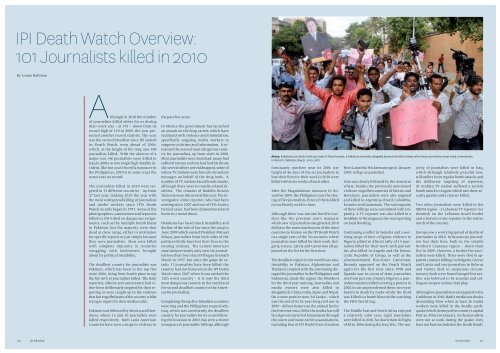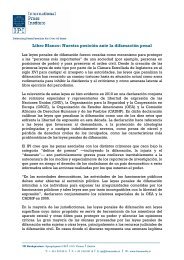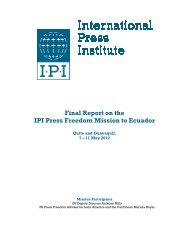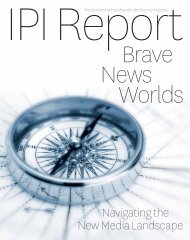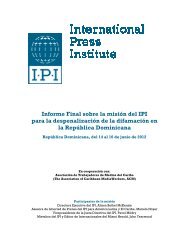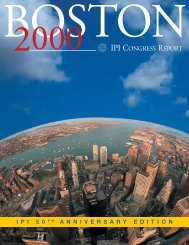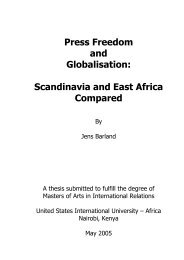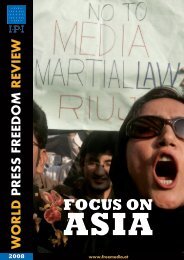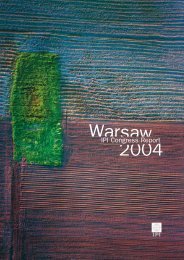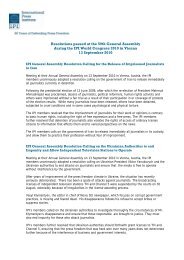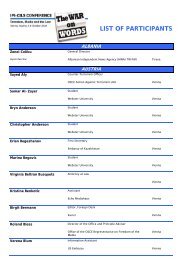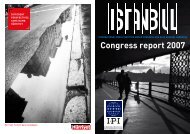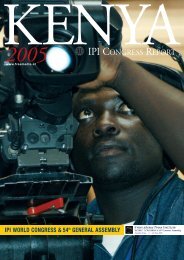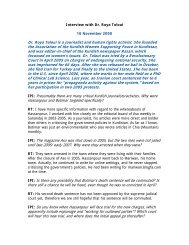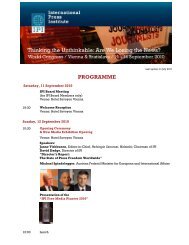FOCUS ON THE AMERICAS - International Press Institute
FOCUS ON THE AMERICAS - International Press Institute
FOCUS ON THE AMERICAS - International Press Institute
Create successful ePaper yourself
Turn your PDF publications into a flip-book with our unique Google optimized e-Paper software.
IPI Death Watch Overview:<br />
101 Journalists killed in 2010<br />
By Louise Hallman<br />
Although in 2010 the number<br />
of journalists killed either for or during<br />
their work was – at 101 – down from its<br />
record high of 110 in 2009, the year presented<br />
another record statistic: The year<br />
was the second bloodiest since IPI started<br />
its Death Watch, even ahead of 2006,<br />
which, at the height of the Iraq, saw 100<br />
journalists killed. With the absence of a<br />
major war (46 journalists were killed in<br />
Iraq in 2006) or one single high-fatality incident,<br />
like last year’s horrific massacre in<br />
the Philippines, 2010 is in some ways the<br />
worst year on record.<br />
The journalists killed in 2010 were targeted<br />
in 33 different countries – up from<br />
27 last year, making 2010 the year with<br />
the most widespread killing of journalists<br />
and media workers since IPI’s Death<br />
Watch records began in 1997. Some of the<br />
photographers, cameramen and reporters<br />
killed in 2010 died on dangerous assignments,<br />
such as the multiple bomb blasts<br />
in Pakistan, but the majority were shot<br />
dead at close range, either in retaliation<br />
for specific reports or just simply because<br />
they were journalists. Most were killed<br />
with complete impunity in countries<br />
struggling with lawlessness brought<br />
about by political instability.<br />
The deadliest country for journalists was<br />
Pakistan, which has been in the top five<br />
since 2006, rising from fourth place to top<br />
the list with 16 journalists killed. The slain<br />
reporters, editors and cameramen had either<br />
been deliberately targeted for their reporting<br />
or were caught up in the violence<br />
that has engulfed parts of the country whilst<br />
trying to report for their media outlet.<br />
Pakistan was followed by Mexico and Honduras,<br />
where 12 and 10 journalists were<br />
killed respectively. Both Latin American<br />
countries have seen a surge in violence in<br />
the past few years.<br />
In Mexico the government has launched<br />
an assault on the drug cartels, which have<br />
retaliated with violence and intimidation,<br />
specifically targeting media workers to<br />
suppress criticism and information. It remained<br />
the second most dangerous country<br />
for journalists, up from sixth in 2008.<br />
Most journalists were shot dead, many had<br />
suffered torture and one had had his throat<br />
slit, several others were kidnapped, some of<br />
whose TV stations were forced to broadcast<br />
messages on behalf of the drug lords. A<br />
number of TV stations faced bomb attacks,<br />
although there were no media-related fatalities.<br />
The remains of Rodolfo Rincón<br />
Taracena were discovered this year. The investigative<br />
crime reporter, who had been<br />
missing since 2007 and one of IPI’s Justice<br />
Denied cases, had been dismembered and<br />
burnt in a metal drum.<br />
Honduras has faced much instability and<br />
decline of the rule of law since the coup in<br />
June 2009 which ousted President Manuel<br />
Zelaya; journalists from both sides of the<br />
political divide have lost their lives in the<br />
ensuing violence. The Central American<br />
state had previously only seen six journalists<br />
lose their lives since IPI began its Death<br />
Watch in 1997, but since the golpe de estado,<br />
11 journalists have been killed; the<br />
country had not featured on the IPI Death<br />
Watch since 2007 when it was ranked the<br />
12th worst country – it is now the third<br />
most dangerous country in the world and<br />
the second deadliest country in the Americas<br />
for journalists.<br />
Completing the top five bloodiest countries<br />
were Iraq and the Philippines respectively.<br />
Iraq, which was consistently the deadliest<br />
country for journalists for six years following<br />
the invasion in 2003, has seen a recent<br />
resurgence in journalists’ killings, although<br />
Above: Pakistani journalists hold a portrait of Talat Hussain, a Pakistani journalist allegedly aboard a flotilla of ships which was stormed by Israel naval commandos,<br />
in Karachi, Pakistan, May 31, 2010. (AP)<br />
fortunately nowhere near its 2006 war<br />
height of 46; four of the six journalists to<br />
lose their lives for their work in 2010 were<br />
killed within six weeks of each other.<br />
After the Maguindanao massacre in November<br />
2009, the Philippines saw the slaying<br />
of five journalists, three of them killed<br />
in one bloody week in June.<br />
Although there was not one horrific incident<br />
like the previous year’s massacre<br />
which saw 32 journalists slaughtered, 2010<br />
did have the notorious honour of the most<br />
countries to feature on the IPI Death Watch<br />
in a single year; of the 34 countries where<br />
journalists were killed for their work, Bulgaria,<br />
Greece, Latvia and Cameroon all appeared<br />
on the list for the first time.<br />
The deadliest region in the world was Asia.<br />
Instability in Pakistan, Afghanistan and<br />
Thailand, coupled with the continuing disregard<br />
for journalists in the Philippines and<br />
Indonesia, made the region the bloodiest<br />
for the third year running. Journalists and<br />
media owners were also killed in<br />
Bangladesh, China, India, Japan and Nepal.<br />
On a more positive note, Sri Lanka – which<br />
saw the end of its 26-year-long civil war in<br />
2009 – did not feature on the annual list for<br />
the first time since 2004; the media has still<br />
faced government-led harassment through<br />
the courts and many earlier assassinations,<br />
including that of IPI World <strong>Press</strong> Freedom<br />
Hero Lasantha Wickrematunge in January<br />
2009, still go unpunished.<br />
Asia was closely followed by the Americas<br />
where, besides the previously mentioned<br />
violence-engulfed countries of Mexico and<br />
Honduras, journalists were also targeted<br />
and killed in Argentina, Brazil, Colombia,<br />
Ecuador and Guatemala. The vast majority<br />
of these killings were committed with impunity.<br />
A TV reporter was also killed in a<br />
landslide in Nicaragua as she was reporting<br />
on local flooding.<br />
Continuing conflict in Somalia and a worrying<br />
surge of inter-religious violence in<br />
Nigeria added to Africa’s tally of 14 journalists<br />
killed for their work, with journalists<br />
also killed in Angola and the Democratic<br />
Republic of Congo, as well as the<br />
aforementioned first-timer Cameroon.<br />
Rwanda appeared on the Death Watch<br />
again for the first time since 1998 and<br />
Uganda saw its count of slain journalists<br />
rise from just one (Jimmy Higenyi, a journalism<br />
student killed covering a protest in<br />
2002) to an unprecedented three; two were<br />
beaten to death by mobs whilst the third<br />
was killed in a bomb blast whilst watching<br />
the FIFA World Cup.<br />
The Middle East and North Africa enjoyed<br />
a relatively calm year; eight journalists<br />
were killed in 2010, far down from its highs<br />
of 48 in 2006 during the Iraq War. The ma-<br />
jority of journalists were killed in Iraq,<br />
which although relatively peaceful now,<br />
still suffers from regular bomb attacks and<br />
the deliberate targeting of reporters.<br />
Al Arabiya TV station suffered a suicide<br />
bomb attack in August which saw three security<br />
guards and a cleaner killed.<br />
Two other journalists were killed in the<br />
MENA region – a Lebanese TV reporter in a<br />
skirmish on the Lebanon-Israeli border<br />
and a Yemeni crime reporter in the restive<br />
north of the country.<br />
Europe saw a worrying spread of deaths of<br />
journalists in 2010. In Russia two journalists<br />
lost their lives, both in the volatile<br />
Northern Caucasus region – down from<br />
five in 2009. However, a further five journalists<br />
were killed. Three were shot in apparent<br />
contract killings in Bulgaria, Greece<br />
and Latvia and two journalists in Belarus<br />
and Turkey died in suspicious circumstances;<br />
both were found hanged but neither<br />
was believed to be suicidal and colleagues<br />
suspect serious foul play.<br />
Although no journalists were targeted in the<br />
Caribbean in 2010, Haiti’s media was dealt a<br />
devastating blow when at least 26 media<br />
workers were killed in the deadly earthquake<br />
which destroyed the country’s capital<br />
Port-au-Prince in January. As the journalists<br />
were not at work during the quake, they<br />
have not been included on the Death Watch.<br />
110 IPI REVIEW<br />
IPI REVIEW 111


